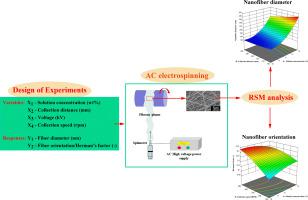当前位置:
X-MOL 学术
›
Mater. Des.
›
论文详情
Our official English website, www.x-mol.net, welcomes your
feedback! (Note: you will need to create a separate account there.)
Analysis and prediction of the diameter and orientation of AC electrospun nanofibers by response surface methodology
Materials & Design ( IF 7.6 ) Pub Date : 2020-09-01 , DOI: 10.1016/j.matdes.2020.108902 Haijun He , Yimeng Wang , Balazs Farkas , Zsombor Kristof Nagy , Kolos Molnar
Materials & Design ( IF 7.6 ) Pub Date : 2020-09-01 , DOI: 10.1016/j.matdes.2020.108902 Haijun He , Yimeng Wang , Balazs Farkas , Zsombor Kristof Nagy , Kolos Molnar

|
Abstract In this study, we analyzed the influence of process parameters on the diameter and orientation of nanofibers electrospun with alternating current (AC), using surface response methodology. The design of experiment was adopted with four main process parameters: solution concentration, collection distance, voltage and collection speed. The morphology of nanofibers was examined with a scanning electron microscope. Nanofiber orientation was characterized by the fast Fourier transform method. We used the Box-Behnken design model to predict the diameter and orientation of the nanofibers, and the results showed good agreement with the measured results. The results also indicated that solution concentration and collection speed have a similar influence on fiber diameter and orientation, as in the case of direct current electrospinning. Furthermore, in this study, we optimized the process parameters to generate thinner nanofibers with better alignment, and it also can be used as a reference to make nanofiber yarns with AC electrospinning.
中文翻译:

响应面法分析和预测交流电纺纳米纤维的直径和取向
摘要 在这项研究中,我们使用表面响应方法分析了工艺参数对交流电 (AC) 电纺纳米纤维的直径和取向的影响。实验设计采用四个主要工艺参数:溶液浓度、收集距离、电压和收集速度。用扫描电子显微镜检查纳米纤维的形态。纳米纤维取向通过快速傅立叶变换方法表征。我们使用 Box-Behnken 设计模型来预测纳米纤维的直径和取向,结果与实测结果吻合良好。结果还表明,溶液浓度和收集速度对纤维直径和取向的影响与直流静电纺丝的情况相似。此外,
更新日期:2020-09-01
中文翻译:

响应面法分析和预测交流电纺纳米纤维的直径和取向
摘要 在这项研究中,我们使用表面响应方法分析了工艺参数对交流电 (AC) 电纺纳米纤维的直径和取向的影响。实验设计采用四个主要工艺参数:溶液浓度、收集距离、电压和收集速度。用扫描电子显微镜检查纳米纤维的形态。纳米纤维取向通过快速傅立叶变换方法表征。我们使用 Box-Behnken 设计模型来预测纳米纤维的直径和取向,结果与实测结果吻合良好。结果还表明,溶液浓度和收集速度对纤维直径和取向的影响与直流静电纺丝的情况相似。此外,











































 京公网安备 11010802027423号
京公网安备 11010802027423号